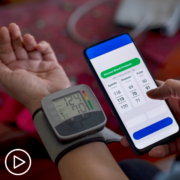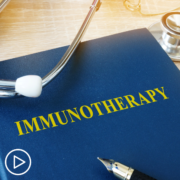What Side Effects Are Possible Following CAR T-Cell Therapy?
What Side Effects Are Possible Following CAR T-Cell Therapy? from Patient Empowerment Network on Vimeo.
Myeloma expert and researcher Dr. Beth Faiman shares an overview of both rare and mild side effects that may affect people who have undergone CAR T-cell therapy. Dr. Faiman also discusses patient monitoring and explains methods to help combat potential issues caused by CAR T-cell therapy.
Dr. Beth Faiman is an Adult Nurse Practitioner in the department of Hematologic Oncology and Blood Disorders at the Cleveland Clinic. Learn more about Dr. Faiman.
See More From Thrive CAR T-Cell Therapy
Related Resources:

|

|

|
Transcript:
Katherine Banwell:
So, after CAR T-cell therapy is completed, what potential side effects might people experience, and what should they look for?
Dr. Beth Faiman:
Absolutely. I think of things in short-term and long-term side effects. So, the short term, you’re going to be admitted to the hospital and you have a risk for – when we get those T cells back – that cytokine release syndrome, or it’s abbreviated CRS – where you’re body’s immune system’s fighting.
I tell folks it’s kind of like if you got a vaccine for a flu vaccine or pneumonia and you had a reaction it’s just way worse. So, you can get a high fever – the big first sign of this CRS. Usually, the providers will jump in with giving you a medication called tocilizumab (Actemra) or a similar drug that blocks IL-6, which is a chemical that is triggered when we get the CRS. And then, it stops those symptoms. And so, most of us know how to do that and will approve your insurance to get access to that tocilizumab or similar drug when we approve your CAR T-cell therapy.
So, that CRS can get you really, really sick. You can get low oxygen levels in your blood. You can get a high fever and you can drop your blood pressure. But most CAR T-cells centers, the nurses and the staff are very well-trained to monitor this every eight hours, in most cases.
Another rare side effect we worry about is ICANS, and it’s a neurotoxicity kind of thing.
It can be with CRS or without CRS. But they’ll ask you to do things like write your name on a piece of paper every eight hours or tell me – draw a clock or count backwards from 100. And so, if you have any deviation, even minor, from what you reported back beforehand then we worry about neurotoxicity. Now, that’s short term but that’s the reason why you can’t drive a car for 30 days is because it could be delayed.
The CRS can start with the one thing, the Ide-cel usually occurs within one day so most people are admitted to the hospital for that CAR T-cell therapy. The Cilta-cel, it onsets to about seven days. So, some people get the Cilta-cel outpatient and then are monitored daily, whether in person or through virtual telehealth monitoring.
But at any rate, those are the short-term. Long-term, we worry about low blood counts maybe for the first month afterwards. And then, those will come back to normal. And then, we worry about infection. So, I mentioned the antibacterial, antiviral, which is usually a medicine called acyclovir (Zovirax), which most myeloma patients will have been on anyhow. And then, that IVIG to protect against viruses and bacteria when your immune system is so low.
But fortunately, if we control the CRS, it usually comes with the CRS, although it can be independent. We try not to give steroids, because we don’t want it to interrupt the CAR T-cell process. But many institutions will give that tocilizumab for ICANS. And if that doesn’t get better then they’ll give you a steroid, such as dexamethasone (Decadron).
And so, that will usually reverse itself pretty quickly. Longer term, after 30 days, you can get with the Carvykti, particularly something called Parkinsonian things where you can get a little bit shaky or something like that. Again, it’s very rare and I have had hundreds of people who have undergone the CAR T-cell procedure at my institution. And knock on wood, fortunately, I’ve not seen first-hand that side effect. And I think it’s because we’re so good now at treating the – preventing the ICANS and CRS as best as we can while they’re inpatient and doing real close following.
One other thing I want to note is if somebody who’s watching this does go in the hospital for any reason, get up and walk around and stay strong, as well as you can, during the procedure. You might be bored if you’re in the hospital anyhow, but try to stay as strong as you can in the hospital. It’ll help your post recovery for sure.
Katherine Banwell:
Well, what about more mild side effects like fatigue and changes in appetite?
Dr. Beth Faiman:
Absolutely. So, the fatigue and the changes in appetite are generally mild for most but I see it, in my experience, if your myeloma’s acting up really quickly, if you’re having a rapid disease progression, the medications that we give you to control the myeloma during this bridging therapy phase might cause some of that as well, not necessarily the CAR T-cell process. But think about it. We’re using your own cells engineered to be fighters.
And so, that first month or two is probably when you’re going to be the most tired as your body is being programmed to fight against the myeloma cells. That fatigue tends to get better. And as I mentioned just a moment earlier, the importance of just walking around in the halls, getting out of bed when you’re in the hospital, that can really help your post recovery. It doesn’t seem like much, but there have been many studies about how muscle mass declines, energy declines when you’re hospitalized.
And we want you to be as strong as you can and thrive as much as you can for when you’re out you can then do the things you want to do at a quicker pace.







